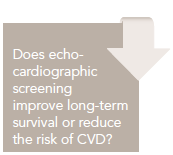Echocardiographic Screening and Long-Term Survival in the General Population

Mushabbar A. Syed, MD
Review
Lindekleiv H, Løchen ML, Mathiesen EB, et al. Echocardiographic screening of the general population and long-term survival: a randomized clinical study. JAMA Intern Med. 2013;173:1592-1598.

Screening echocardiography is generally recommended in asymptomatic individuals with a family history of sudden death or hereditary cardiovascular diseases. Identification of structural heart disease in asymptomatic individuals may improve prognosis by potentially allowing treatment of early disease. This study examined whether echocardiographic screening for structural heart disease in the general population improves long-term survival or reduces risk of cardiovascular disease.
Study Design
Lindekleiv et al studied 6861 middle-aged participants from the population- based Tromsø Study conducted in Norway. Subjects were randomly allocated to echocardiography (screening group = 3272) or no echocardiography (control group = 3589). Data collection included self-reported questionnaires, physical examination, and nonfasting blood samples. Ten-year risk of fatal cardiovascular disease was calculated by the Systematic Coronary Risk Evaluation (SCORE) method,1 based on age, sex, smoking habits, systolic blood pressure, total cholesterol, and high-density lipoprotein (HDL) cholesterol levels. All participants underwent separate ultrasound screening for abdominal aortic aneurysm and carotid artery stenosis, which showed 345 participants (5.0%) with abdominal aortic aneurysm and 248 individuals (3.6%) with carotid artery stenosis.
Echocardiographic examination was performed by 3 trained physicians. Predefined criteria for referral to clinical follow-up included: wall thickness >1.4 cm, aortic root >4.5 cm, mitral stenosis, aortic stenosis with peak gradient >30 mm Hg, mitral regurgitation with regurgitant jet area >4 cm2, aortic regurgitation with jet >30% of left ventricular (LV) outflow tract diameter or reaching the bottom of LV, LV diastolic diameter >6.5 cm, LV ejection fraction <50%, and hereditary or anatomic abnormalities. A total of 362 participants met these criteria, of whom 290 (8.9%) had follow-up evaluation including complete history, clinical examination, transthoracic echocardiography (TTE), resting and exercise electrocardiography, and transesophageal echocardiography or invasive studies if clinically indicated.
Primary outcome was all-cause mortality. Secondary outcomes included sudden death, death from heart disease, fatal and nonfatal myocardial infarction (MI), and stroke. Participants were followed up until the occurrence of death, emigration from Norway, or end of the follow-up period at 15 years, whichever occurred first.
Among the echocardiographic screening group, the prevalence of structural or valvular heart disease was 7.6%, and the most common finding was valvular heart disease (3.3%) followed by LV hypertrophy (1%) and ventricular dysfunction (1%).
During 15 years of follow up, 880 subjects (26.9%) in the screening group and 989 (27.6%) in the control group died (P = .48). Similarly, there was no difference between incident MI (12.8% vs 13.5%, P = 0.32) and stroke (9.8% vs 9.6%, P = .92). Despite cardiology followup of abnormal findings in the screening group, mortality, MI, and stroke were unchanged between the 2 groups. Adjustment for potential confounding variables did not change the results.
In the unadjusted analysis, screening was associated with reduced risk of death from all causes in participants with a family history of early MI but not in other subgroups (with hypertension, diabetes mellitus, or low/moderate/high 10-year risk of fatal cardiovascular disease). However, this finding was not significant after adjustment for multiple comparisons (Bonferroni correction), suggesting a type 1 error.
In conclusion, the Tromsø cohort study found no benefit of echocardiographic screening for structural and valvular heart disease in the general population. The study findings support the current guidelines that recommend against routine echocardiography for cardiovascular risk assessment in asymptomatic adults.
CommentaryIs There a Benefit to Routine Echocardiographic Screening?
The rationale behind screening for cardiovascular disease is early detection in an asymptomatic stage so that appropriate therapy can be instituted to improve future outcomes. Several biomarkers and imaging tests, including C-reactive protein, coronary calcium scoring, carotid intima-media thickness, and ankle- brachial index, have been tested in this setting. Although there is general agreement that these tests can detect early cardiovascular disease, there is lack of agreement on which test is best, when/who to screen, and overall appropriateness of this approach. There is also a paucity of evidence whether treating early cardiovascular disease in asymptomatic subjects improves clinical outcomes.
Transthoracic echocardiography (TTE) is a widely used imaging modality for diagnosis and management of cardiovascular diseases. TTE is primarily useful in detection of structural heart disease, while the detection of coronary artery disease by regional wall motion assessment is not reliable. TTE has been shown to be portable, can be performed in different clinical settings, and is technically feasible in a majority of subjects,2 features that make TTE a potential screening tool. The Tromsø cohort study utilized TTE for cardiovascular disease screening by allocating half of the cohort to TTE and using the other half as a control group. Their results show that TTE does detect cardiovascular abnormalities in 11% of subjects screened; however, despite cardiology evaluation of abnormal findings, there was no difference in mortality between the TTE and control groups over 15 years of follow-up. There was also no reduction in incident MI or stroke associated with TTE screening. The Tromsø study was not designed as a randomized clinical trial of TTE screening and the analysis was limited by its as-screened approach rather than intent-to-screen approach. Limitations also include the impact of other vascular screenings performed in this cohort—ie, carotid and abdominal aortic ultrasound examinations that may have affected 1 group more than other. These limitations aside, this was a large population-based TTE screening study with long-term follow up that was not able to show any benefit of TTE screening.
The American College of Cardiology Foundation (ACCF)/American Heart Association (AHA) 2010 guidelines for assessment of cardiovascular risk in asymptomatic adults give a class IIb (level of evidence, B) recommendation for screening echocardiography to detect left ventricular hypertrophy in asymptomatic patients with hypertension.3 These guidelines recommend against echocardiographic screening in asymptomatic adults without hypertension (class III recommendation). The American Society of Echocardiography 2011 appropriate use criteria consensus statement also does not endorse routine echocardiography screening in the absence of symptoms or signs of cardiovascular disease.4 While considering screening for cardiovascular disease, the harmful effects of these screening tests should also be considered.5 Selection among tests should be based upon local availability and expertise, costs, and potential risk such as radiation exposure. Incidental findings are seen frequently on imaging screening tests that may require clinical follow up, further testing, and anxiety. Detection of small lung nodules on cardiac CT is an example of such incidental findings. Total cost of a screening test should also include downstream testing costs for follow up of incidental findings.
Based on 2010 ACCF/AHA guidelines, all asymptomatic adults should be risk stratified by global risk scores such as the Framingham risk score based on age, sex, and traditional cardiovascular risk factors (class I recommendation). Subjects are then classified into low-risk, intermediate-risk, and high-risk categories. There is general consensus that individuals at low risk or documented high risk do not require further testing, as added testing will not provide incremental benefit to guide management decisions. There is lack of agreement on further testing and management of intermediaterisk patients. In selected individuals at intermediate risk, further risk stratification can be performed with noninvasive imaging by coronary calcium scoring or carotid intima-media thickness (class IIa recommendation). It’s important to note that the role of these and other screening tests for modifying patient outcomes remains untested.
References
1. Conroy RM, Pyörälä K, Fitzgerald AP, et al; SCORE Project Group. Estimation of ten-year risk of fatal cardiovascular disease in Europe: the SCORE project. Eur Heart J. 2003;24:987-1003.
2. Weiner RB, Wang F, Hutter Jr, AM, et al. The feasibility, diagnostic yield and learning curve of portable echocardiography for out of hospital cardiovascular disease screening. J Am Soc Echocardiogr. 2012;25(5):568- 575.
3. Greenland P, Alpert JS, Beller GA, et al. 2010 ACCF/AHA guideline for assessment of cardiovascular risk in asymptomatic adults: a report of the American College of Cardiology Foundation/American Heart Association Task Force on Practice Guidelines. Circulation. 2010;122:e584-e636.
4. Douglas PS, Garcia MJ, Haines DE, et al. ACCF/ASE/AHA/ ASNC/ HFSA/HRS/SCAI/SCCM/SCCT/SCMR 2011 appropriate use criteria for echocardiography: a report of the American College of Cardiology Foundation Appropriate Use Criteria Task Force, American Society of Echocardiography, American Heart Association, American Society of Nuclear Cardiology, Heart Failure Society of America, Heart Rhythm Society, Society for Cardiovascular Angiography and Interventions, Society of Critical Care Medicine, Society of Cardiovascular Computed Tomography, and Society for Cardiovascular Magnetic Resonance. J Am Soc Echocardiogr. 2011;24:229-267.
5.Lauer MS. Screening for coronary heart disease: has the time for universal imaging arrived? Cleveland Clinic J Med. 2007;74:645-650.
About the Author
Mushabbar A. Syed, MD, FACC, is Director of Cardiovascular Imaging and Rolf and Merian Gunner Professor of Medicine (Cardiology), Radiology and Cell & Molecular Physiology at Loyola University of Chicago’s Stritch School of Medicine. He received his MD from King Edward Medical College, Lahore, Pakistan, and completed residencies in Pakistan, Great Britain, and at Henry Ford Hospital in Detroit, MI, where he also completed fellowships in Cardiology and Echocardiography. He also completed a fellowship in Cardiovascular MRI at the National Institutes of Health. His areas of interest include cardiovascular imaging, structural heart disease, and coronary artery disease.
